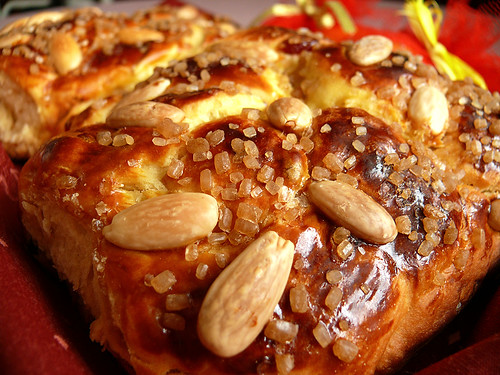
Easter comes a week later in Bulgaria. In the west of the Christian world, Easter lunches and early family dinners are long forgotten, digested, assimilated and worked off. Here, we are still battling the drama of Easter bread.
It's easy to spot the differences between the typical North American Easter meal and the Orthodox Christian traditional meal. Most people in the US, for example, will have one family gathering, where salad, ham and potatoes and possibly some cake will be present. Less of a feast than Thanksgiving and very similar to Christmas. If you happen to like Peeps, and end up roasting one of the poor things, you might have one before you've had enough.
Here, in the east, the nutritional drama begins with baking the traditional Easter cookies, usually on Thursday, ones rich in lard, butter and sunflower oil, sprinkled with sugar crystals and smelling so good, that all neighbors want to come and exchange recipes with you. Thus, Friday starts with coffee and one two or three of grandma's cookies. Saturdays see the making of traditional Easter bread, a yeast based fluffy, doughy treat, that is both sweet and not very filling, one that you can have a lot of and one that mates beautifully with butter and jam, dunks famously in milk and coffee and is best eaten with a bowl of fullfat plain yogurt. Since most families are serious about their Easter bread, they use the same dough to make mini scones and rolls and fill them with plum preserves, raisins, almonds and walnuts. These are best eaten warm out of the oven, and cause zero satiety. which is why two or more of them are usually what one eats while making Easter Bread. Dinner on Saturday is served after and before a piece of the aforementioned treat and Sunday breakfast is mostly the same bread with boiled eggs that fell victims of egg fights (in an egg fight, you just hit two eggs together, there is no throwing happening, much to the contrary of what some foreigners imagine). Sunday lunch is traditional lamb roast with rice stuffing, also followed by eggs and Easter bread. Of course, tea and coffee in the afternoon are accompanied by each faimily's traditional cookies and Easter breads, but now joined by their neighbors' and relatives's recipes too, since it's a tradition to bring those to people you love and care for...

To sum up, Orthodox Easter looks like your normal menu with the following additons:
Thursday night: warm cookies
Friday morning: cookies
Friday night in front of TV: cookies
Saturday: warm scones and rolls and Easter Bread
Sunday: now colder Easter Bread with butter and jam and plenty of eggs and lamb
After 4 days like this, most of my clients show up slightly bloated and needing extra training sessions to offset the calories they consumed.
Luckily, it's hard to eat over 4 lbs of Easter bread, which is how much it takes to put on 2 lbs of fat.





3 comments:
4lbs sounds like a challenge
Ah, you're making me hungry with all this Easter food talk and I love celebrating it twice :)Easter seems so much more important and special in Bulgaria than it does in the US, doesn't it?
Indeed, it's bigger than Xmas here :)
Post a Comment